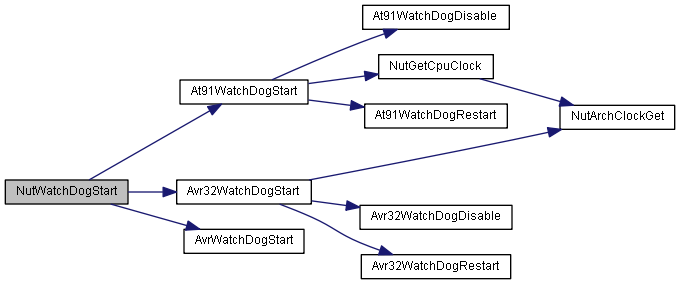Watchdog Support. More...

|
Functions | |
| uint32_t | NutWatchDogStart (uint32_t ms, uint32_t xmode) |
| Start the watch dog timer. | |
| void | NutWatchDogRestart (void) |
| Restart the watch dog timer. | |
| void | NutWatchDogDisable (void) |
| Disables the watch dog timer. | |
| void | NutWatchDogEnable (void) |
| Enables the watch dog timer. | |
Watchdog Support.
Platform independent watchdog support is available for the AVR platform and the AT91R40008 MCU.
Start the watch dog timer.
This function can be used by applications to prevent hang-ups.
| ms | Watch dog time out in milliseconds. |
| xmode | Hardware specific mode. If 0, the default mode is used. In this mode, the watch dog will reset the CPU if not restarted within the specified time out period. |
The following code fragment starts the watch timer with a time out of 550 milliseconds and restarts it every 500 milliseconds.
#include <dev/watchdog.h> #include <sys/timer.h> NutWatchDogStart(550, 0); for(;;) { NutWatchDogRestart(); NutSleep(500); }
Definition at line 50 of file watchdog.c.
References At91WatchDogStart(), Avr32WatchDogStart(), and AvrWatchDogStart().
Referenced by Avr32Reset().

| void NutWatchDogRestart | ( | void | ) |
Restart the watch dog timer.
Definition at line 66 of file watchdog.c.
References At91WatchDogRestart(), Avr32WatchDogRestart(), and AvrWatchDogRestart().

| void NutWatchDogDisable | ( | void | ) |
Disables the watch dog timer.
Applications should call this function to temporarily disable the watch dog timer. To re-enable it, call NutWatchDogEnable().
#include <dev/watchdog.h> NutWatchDogStart(100, 0); //Some code here. NutWatchDogRestart(); //Some code here. NutWatchDogDisable(); //Some lengthy code here, like writing to flash memory. NutWatchDogEnable();
Definition at line 80 of file watchdog.c.
References At91WatchDogDisable(), Avr32WatchDogDisable(), and AvrWatchDogDisable().

| void NutWatchDogEnable | ( | void | ) |
Enables the watch dog timer.
The function can be safely used within nested subroutines. The watch dog will be enabled only, if this function is called the same number of times as NutWatchDogDisable(). If enabled, the watch dog timer will also have been re-started and the full time out value is available before another NutWatchDogRestart() is required.
If the watch has not been started by NutWatchDogStart(), then this function does nothing.
Definition at line 94 of file watchdog.c.
References At91WatchDogEnable(), Avr32WatchDogEnable(), and AvrWatchDogEnable().
